The Samsung 860 QVO (1TB, 4TB) SSD Review: First Consumer SATA QLC
by Billy Tallis on November 27, 2018 11:20 AM ESTWhole-Drive Fill: Testing SLC Cache Size
This test starts with a freshly-erased drive and fills it with 128kB sequential writes at queue depth 32, recording the write speed for each 1GB segment. This test is not representative of any ordinary client/consumer usage pattern, but it does allow us to observe transitions in the drive's behavior as it fills up. This can allow us to estimate the size of any SLC write cache, and get a sense for how much performance remains on the rare occasions where real-world usage keeps writing data after filling the cache. Samsung's official specifications are:
| Samsung 860 QVO Secondary Specifications | |||||
| Capacity | 1 TB | 2 TB | 4 TB | ||
| SLC Cache Size |
Min | 6 GB | 6 GB | 6 GB | |
| Max | 42 GB | 78 GB | 78 GB | ||
| Sequential Write |
SLC Cache | 520 MB/s | |||
| QLC | 80 MB/s | 160 MB/s | 160 MB/s | ||
Our results show the following:
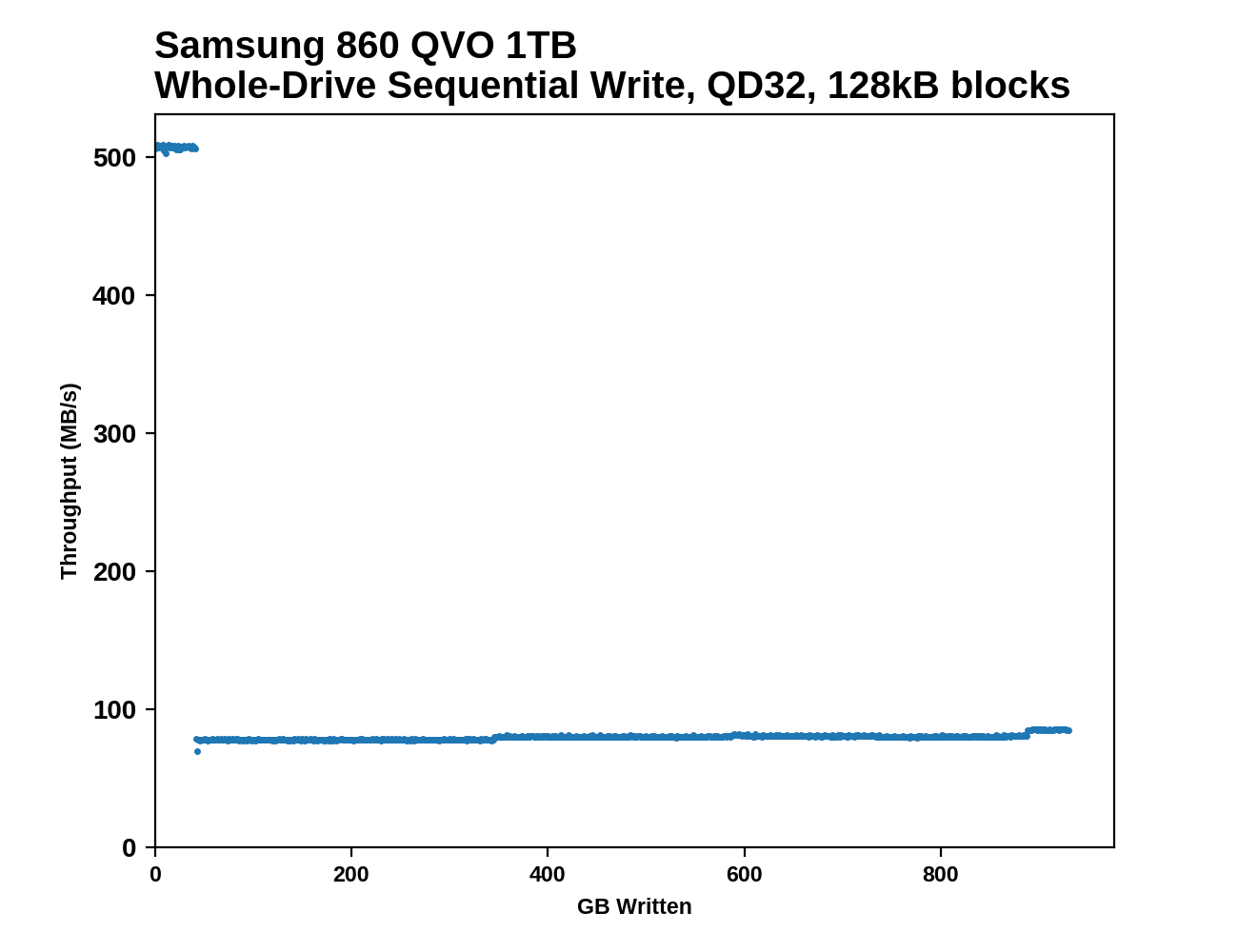 |
|||||||||
The Samsung 860 QVOs run out of SLC cache right on schedule, at 42 GB for the 1TB model and 78 GB for the 4TB. After that, they are both slow and very steady for the rest of the test.
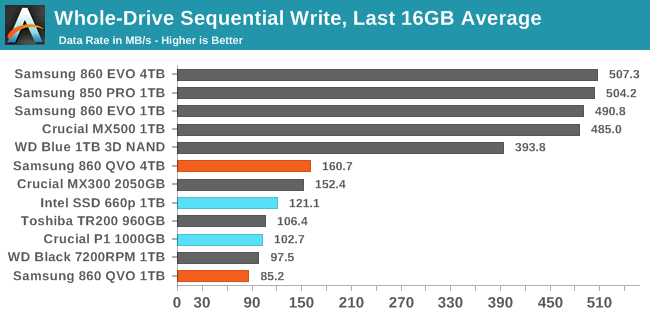 |
|||||||||
| Average Throughput for last 16 GB | Overall Average Throughput | ||||||||
The 1TB 860 QVO falls below the sequential write speed of a 1TB hard drive once the SLC cache runs out, but the 4TB model is able to sustain twice the write speed and remains ahead of not just the hard drive's speed, but also some of the slower TLC drives.
BAPCo SYSmark 2018
BAPCo's SYSmark 2018 is an application-based benchmark that uses real-world applications to replay usage patterns of business users, with subscores for productivity, creativity and responsiveness. Scores represnt overall system performance and are calibrated against a reference system that is defined to score 1000 in each of the scenarios. A score of, say, 2000, would imply that the system under test is twice as fast as the reference system.
SYSmark scores are based on total application response time as seen by the user, including not only storage latency but time spent by the processor. This means there's a limit to how much a storage improvement could possibly increase scores, because the SSD is only in use for a small fraction of the total test duration. This is a significant difference from our ATSB tests where only the storage portion of the workload is replicated and disk idle times are cut short to a maximum of 25ms.
| AnandTech SYSmark SSD Testbed | |
| CPU | Intel Core i5-7400 |
| Motherboard | ASUS PRIME Z270-A |
| Chipset | Intel Z270 |
| Memory | 2x 8GB Corsair Vengeance DDR4-2400 CL17 |
| Case | In Win C583 |
| Power Supply | Cooler Master G550M |
| OS | Windows 10 64-bit, version 1803 |
Our SSD testing with SYSmark uses a different test system than the rest of our SSD tests. This machine is set up to measure total system power consumption rather than just the drive's power.
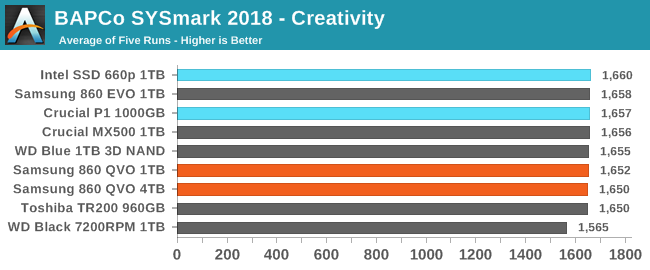
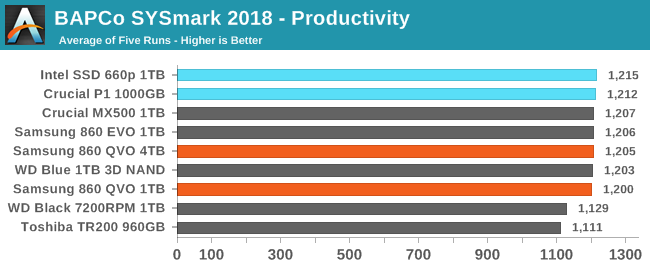
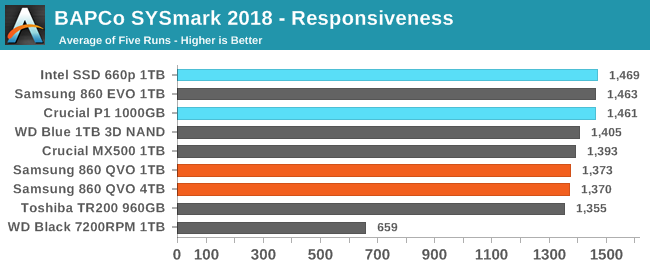
The 860 QVO isn't any slower for compute-heavy interactive tasks than the mainstream SATA SSDs, and even on the more I/O-bound Responsiveness test the 860 QVO is ahead of the DRAMless TLC drive and not far behind the Crucial MX500.
Energy Use
The SYSmark energy usage scores measure total system power consumption, excluding the display. Our SYSmark test system idles at around 26 W and peaks at over 60 W measured at the wall during the benchmark run. SATA SSDs seldom exceed 5 W and idle at a fraction of a watt, and the SSDs spend most of the test idle. This means the energy usage scores will inevitably be very close. A typical notebook system will tend to be better optimized for power efficiency than this desktop system, so the SSD would account for a much larger portion of the total and the score difference between SSDs would be more noticeable.
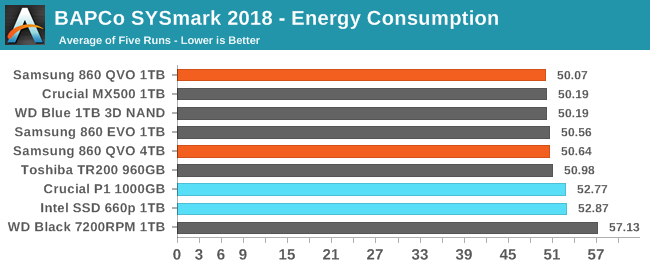
The Samsung 860 QVO's energy usage during SYSmark is not a problem at all, with it using slightly less energy than the mainstream SATA TLC drives.










109 Comments
View All Comments
stanleyipkiss - Tuesday, November 27, 2018 - link
Sell me a 8 TB QLC SSD for $400 and I'll bite. That's what QLC is for: moving off of spinning rust and onto SSDs with my bulk storage. Until then, this is useless without MASSIVE price drops. They are trying to milk saps who can't tell the difference between SSDs (i.e. normal consumers) by not dropping prices... yet.The race to the bottom for SSDs is coming. The manufacturers are just greedy enough not to want it to happen too soon.
But give me an 8TB or bigger SSD for $400 and I'll be the first to buy it. I'll even buy two!
R0H1T - Tuesday, November 27, 2018 - link
Yeah no one's selling you 8TB for $400 anytime soon. Aside from the fact that the R&D costs for QLC need to be recuperated first & companies need to reinvest an increasing amount for future development, there's also a point after which it doesn't make sense for the SSD, or NAND, maker to sell these at a loss.If you really want something that big, for dirt cheap, try spinners instead.
shabby - Tuesday, November 27, 2018 - link
How will they recoup the price when no one is going to buy this? The evo 860 is cheaper.R0H1T - Tuesday, November 27, 2018 - link
So you think the 860 QVO will stay at 15c/GB for the rest of it's time on the market or have you not seen high prices at launch, for any other product before this?shabby - Tuesday, November 27, 2018 - link
Obviously no, but why launch it at this price from the start. Should of launched it at $99 for 1tb that would probably get it some fanfare.R0H1T - Tuesday, November 27, 2018 - link
Early adopter tax? Samsung is usually the first to launch "one of a kind" products in the retail market & they get the ball rolling for many of the innovations in this industry. The prices would come down sooner if the competitors launch their SATA QLC drives quickly.shabby - Tuesday, November 27, 2018 - link
I doubt anyone will be rushing to the store to buy these.Ironchef3500 - Wednesday, November 28, 2018 - link
+1Jad77 - Wednesday, November 28, 2018 - link
"I doubt anyone will be rushing to the store to buy these."That is the perfect one-line review!
moozooh - Tuesday, November 27, 2018 - link
Yeah, the problem here is that the QVO is not a "one of a kind product"—in every possible aspect and scenario it's either the same as the EVO or worse, sometimes very substantially so, without being substantially cheaper. Right now there is exactly zero reason to choose it over the EVO. In order to compete with it favorably the QVO needs to be at least 25% cheaper to offset the disadvantages. In other words, under 11 c/GB. Until then nobody would be willing to give this inferior product the time of the day.